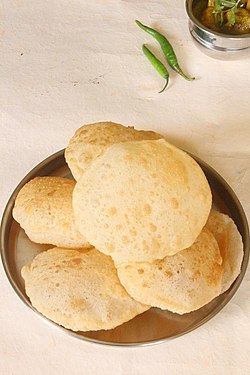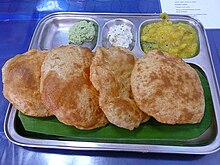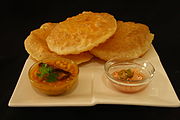Puri (food)
 | |
| Place of origin | South Asia |
|---|---|
| Region or state | South Asia, Southeast Asia |
| Associated national cuisine | India, Bangladesh, Pakistan, Nepal, Malaysia, Myanmar, Singapore, Sri Lanka, Mauritius, Trinidad and Tobago |
| Serving temperature | Hot |
| Main ingredients | Atta |
| Variations | Bhatoora, Luchi, Sevpuri, Panipuri |
Puri (sometimes spelled as poori) is a deep-fried bread made from unleavened whole-wheat flour that originated in the Indian subcontinent. It is eaten for breakfast or as a snack or light meal. It is usually served with a savory curry or bhaji, as in puri bhaji, but may also be eaten with sweet dishes.
Puris are most commonly served as breakfast and snacks. It is also served at special or ceremonial functions as part of ceremonial rituals along with other vegetarian food offered in prayer as prasadam.
Name[]
The name puri derives from the Sanskrit word पूरिका (pūrikā), from पुर (pura) "filled".[1] In other Indian languages it is known as: Tamil: பூரி (boori) ,Telugu: పూరి (pūri), Gujarati: પૂરી, Assamese: পুৰি (puri), Bengali: পূরি (pūrī), Hindi: पूड़ी (pūḍī), Bhojpuri: पूड़ी (pūḍī), Marathi: पूरी (pūrī), Kannada: ಪೂರಿ (pūri), Malayalam: പൂരി, Burmese: ပူရီ (pūrī), Nepali: पूरी (puri), Odia: ପୁରି (puri), Punjabi: ਪੁੜੀ (pūḍī), Urdu: Garhwali swai (स्वाई)پوری (puri).[2]
Ingredients[]
Puris are prepared with wheat flour, either atta (whole wheat flour) or sooji (coarse wheat flour). In some recipes, ajwain, cumin seed, spinach, or fenugreek seeds are added to the dough. The dough is either rolled out in a small circle or rolled out and cut out in small circles, then deep fried in ghee or vegetable oil. While deep frying, puris puff up like a round ball because moisture in the dough changes into steam which expands in all directions. When they are golden-brown in color, they are removed and either served hot or saved for later use (as with the snack food pani puri). Rolled puris may be pricked with a fork before deep frying to make flat puris for chaat like bhel puri. A punctured puri does not puff when cooked because the steam escapes as it cooks.
Accompaniments[]

Puri can be eaten with many savory accompaniments, including korma, chana masala, dal, potato-based curries (for example, saagu, bhaji, bhujia, Aloo ki tarkari, shaak, and sambharo), shrikhand and basundi. In some parts of India, puri is also served with a mixed vegetable dish that is prepared during Puja. Puri is also eaten with sweet accompaniments, such as kheer (a dessert prepared with rice, milk and sugar) or halwa (in Hindi-speaking regions of India, the expression "Halwa puri khana", "to eat puri with halwa", signifies a celebration – of possibly modest means). Puri is often the bread of choice for festivals and special occasions.
In southern India, puri is almost always made for breakfast, and on the east coast (Andhra, Tamil Nadu) it's rarely eaten with non-vegetarian dishes. Often, they will be served with pickles, chutneys, dal masalas, potato masala, or gourd curry (either ivy, ridge, or bottle varieties).
Types, variants[]
A variant of puri is bhatoora, which is three times the size of a puri and served with chholey (spicy chick peas). It often constitutes a full meal. (See chole bhature). Bhatoora bread is with yeast and puri bread made from unleavened dough.[3]
In the Indian state of Odisha a large size puri is made during Bali Yatra which is called thunka puri (Odia: ଠୁଙ୍କା ପୁରି).[4][5][6][7][8]
Another variant, largely popular in the Northern Indian state of Uttar Pradesh is bedvi. It is a saltier and stiffer version of the regular puri, and is often stuffed with lentils.
Another variant of the puri popular in the eastern states of West Bengal and Odisha is the luchi. In Assam, it is pronounced as lusi. Luchis in Bengal are served with typical side dishes like aloor dum (potato preparation), begun bhaja (fried eggplant) and others
The puris used for panipuri are smaller, and are usually made crisper by the addition of rava/sooji (semolina) to the dough.
Sev puri is an Indian snack offered by street vendors who serve chaat.
Street vendors in Mumbai serve bhel in a throw-away folded leaf with a flat puri to scoop it.

Puri Frying in Pakistan

Puri is traditionally deep fried.
Dal puri, a traditional Bengali version

Aloo Puri, typical morning snack, Varanasi
Mini-puris are part of panipuri snack. It's crunchier in texture.

Daal puri, Bangladesh

Thin bread is fried in oil and eaten with salty curry of chickpeas potatoes and sweet pudding.
See also[]
- List of Indian breads
- List of Pakistani breads
- Kulcha
- Khachapuri
- Shelpek
References[]
- ^ Tokuji Watanambe (1986). Traditional Foods: Some Products and Technologies. Central Food Technological Research Institute. p. 56.
- ^ Tokuji Watanambe (1986). Traditional Foods: Some Products and Technologies. Central Food Technological Research Institute. p. 56.
- ^ Ramineni, Shubhra (28 February 2012). Entice With Spice: Easy Indian Recipes for Busy People. ISBN 9781462905270.
- ^ "Overview of Cuttack". Archived from the original on 13 August 2011. Retrieved 28 November 2011.
- ^ Fanfare & spectacle mark the opening of Bali Yatra Archived 3 April 2015 at the Wayback Machine, 10 November 2011
- ^ Orissa CM Naveen Patnaik inaugurates historic Baliyatra festival in Cuttack, 22 November 2010
- ^ Bali Yatra Fever grips Cuttack, 12 November 2011 Archived 13 November 2011 at the Wayback Machine
- ^ Binita Jaiswal, Fanfare & spectacle mark the opening of Bali Yatra, 10 November 2011
External links[]
| Wikibooks Cookbook has a recipe/module on |
| Wikimedia Commons has media related to Puri (food). |
- Indian fast food
- Indian breads
- Punjabi cuisine
- Sindhi cuisine
- Muhajir cuisine
- Pakistani fast food
- Pakistani breads
- Uttar Pradeshi cuisine
- Flatbreads
- Unleavened breads
- Tamil cuisine
- Odia cuisine
- Bengali cuisine
- Nepalese cuisine
- Sri Lankan cuisine
- Telangana cuisine
- Andhra cuisine
- Karnataka cuisine
- Malaysian breads
- Gujarati cuisine
- Deep fried foods
- Bangladeshi cuisine
- Burmese cuisine
- Indian cuisine
- Pakistani cuisine
- Guyanese cuisine












